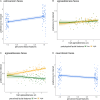Neural dynamics of personality trait perception and interaction preferences
- PMID: 39668166
- PMCID: PMC11638252
- DOI: 10.1038/s41598-024-76423-9
Neural dynamics of personality trait perception and interaction preferences
Abstract
According to recent research, self-reported Big Five personality traits are associated with preferences for faces that are representative of certain Big Five traits. Previous research has primarily focused on either preference for distinct prototypical personality faces or the accuracy of trait ratings for these faces. However, the underlying neural correlates involved in the processing of prototypical personality faces are unknown. In the present study, we aim to bridge this gap by investigating whether participants' Big Five personality traits predict preferences to interact with individuals represented by prototypical personality faces, as well as the neural processing of these facial features. Based on theoretical considerations and previous research, we focus on trait extraversion, agreeableness and neuroticism, and corresponding prototypical faces. Participants were asked to classify prototypical faces as above or below average representative of a certain trait, and then provide an interaction preference rating while face-sensitive event-related potentials (N170 and late positive potential) were measured. In line with our hypotheses, the results showed an interaction preference for faces that were perceived as high (vs. low) extraverted and agreeable and low (vs. high) neurotic. In addition, the preference for agreeable faces interacted with personality characteristics of the perceiver: The higher a persons' score on trait agreeableness, the higher the face preference ratings for both prototypical and perceived high agreeable faces. Analyses of ERP data showed that an increase in preference ratings for prototypical agreeable faces was paralleled by an increase of the late positive potential. Notably, the N170 did not show any neural signature of the hypothesized effects of personality faces. Together, these results highlight the importance of considering both perceiver characteristics as well as perceived features of an interaction partner when it comes to preference for social interaction.Protocol registration The stage 1 protocol for this Registered Report was accepted in principle on the 8th of May 2023. The protocol, as accepted by the journal, can be found at: https://doi.org/10.17605/OSF.IO/G8SCY .
© 2024. The Author(s).
Conflict of interest statement
Declarations. Competing interests: The authors declare no competing interests.
Figures






References
-
- Jack, R. E. & Schyns, P. G. The Human Face as a Dynamic Tool for Social Communication. Curr. Biol. 25, R621–R634 (2015). - PubMed
-
- Brown, M., Sacco, D. F. & Medlin, M. M. Approaching extraverts: Socially excluded men prefer extraverted faces. Personal. Individ. Differ. 137, 198–203 (2019).
-
- Holtzman, N. S. Facing a psychopath: Detecting the dark triad from emotionally-neutral faces, using prototypes from the Personality Faceaurus. J. Res. Personal. 45, 648–654 (2011).
-
- Sacco, D. F. & Brown, M. The face of personality: Adaptive inferences from facial cues are moderated by perceiver personality and motives. Soc. Personal. Psychol. Compass 12, (2018).
MeSH terms
LinkOut - more resources
Full Text Sources
Miscellaneous

